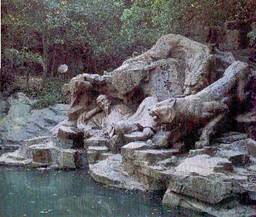Hupao Spring (Running-Tiger Spring)
The Hupao Spring is located in the side yard of the Huichan Temple (commonly known as the Hupao Temple), which is at the foot of the Baihe Peak (White Crane Peak) of Daci Mountain, five kilometers from Hangzhou City, Zhejiang Province. The Hupao Spring takes its name from a legend. According to the legend, an accomplished monk named Huanzhong came and lived here during the 14th year (819) of the Yuanhe reign in the Tang Dynasty (618-907). Later, due to lack of water, the monk planned to leave the temple. One night, he had a dream in which an immortal told him two tigers would move a fountain here. As expected, the next day two mighty tigers from the Hengshan Mountain circled the spot and dug a hole which caused the spring to gush forth -- hence, the name Hupao Spring (Running - Tiger Spring).
 In reality, the Hupao Spring is formed by underground water seeping through veins and cracks within quartz sandstone. According to measurement, the rate of flow reaches 43.2 to 86.4 cubic meters per day. With pure and sweet water, the spring holds the first place among springs in the West Lake. The Hupao Spring and the Longjing (Dragon Well) Spring are reputed to be the third spring under heaven. In reality, the Hupao Spring is formed by underground water seeping through veins and cracks within quartz sandstone. According to measurement, the rate of flow reaches 43.2 to 86.4 cubic meters per day. With pure and sweet water, the spring holds the first place among springs in the West Lake. The Hupao Spring and the Longjing (Dragon Well) Spring are reputed to be the third spring under heaven.
Originally, the Hupao Spring had three wells, which formed two pools later. Next to the main pool, there is a stone bed placed in a stone niche. A sculpture of Monk Huanzhong is lying on his side, resting the head on his right arm in a serene manner. Two lifelike stone tigers stand to the right side of the stone niche, as if they are walking towards Huanzhong. stone bed placed in a stone niche. A sculpture of Monk Huanzhong is lying on his side, resting the head on his right arm in a serene manner. Two lifelike stone tigers stand to the right side of the stone niche, as if they are walking towards Huanzhong.
Since ancient times, the Dragon-Well Tea and the Hupao Spring water have been known as the "two wonders of the West Lake." Through the ages, visitors who came to Hangzhou City all took the opportunity to sip and taste the Dragon-Well Tea with Hupao Spring water. Many poets wrote poems to praise the Hupao Spring.
In recent years, the development of tea culture in Hangzhou City was promoted by the flourishing tourism. Nowadays, several teahouses have been restored or constructed along the scenic spots in the West Lake, such as the Hupao Spring, the Longjing Spring, Yu Spring (Jade Spring) and Wushan, attracting tea lovers both home and abroad.
Source: http://www.chinaculture.org |
